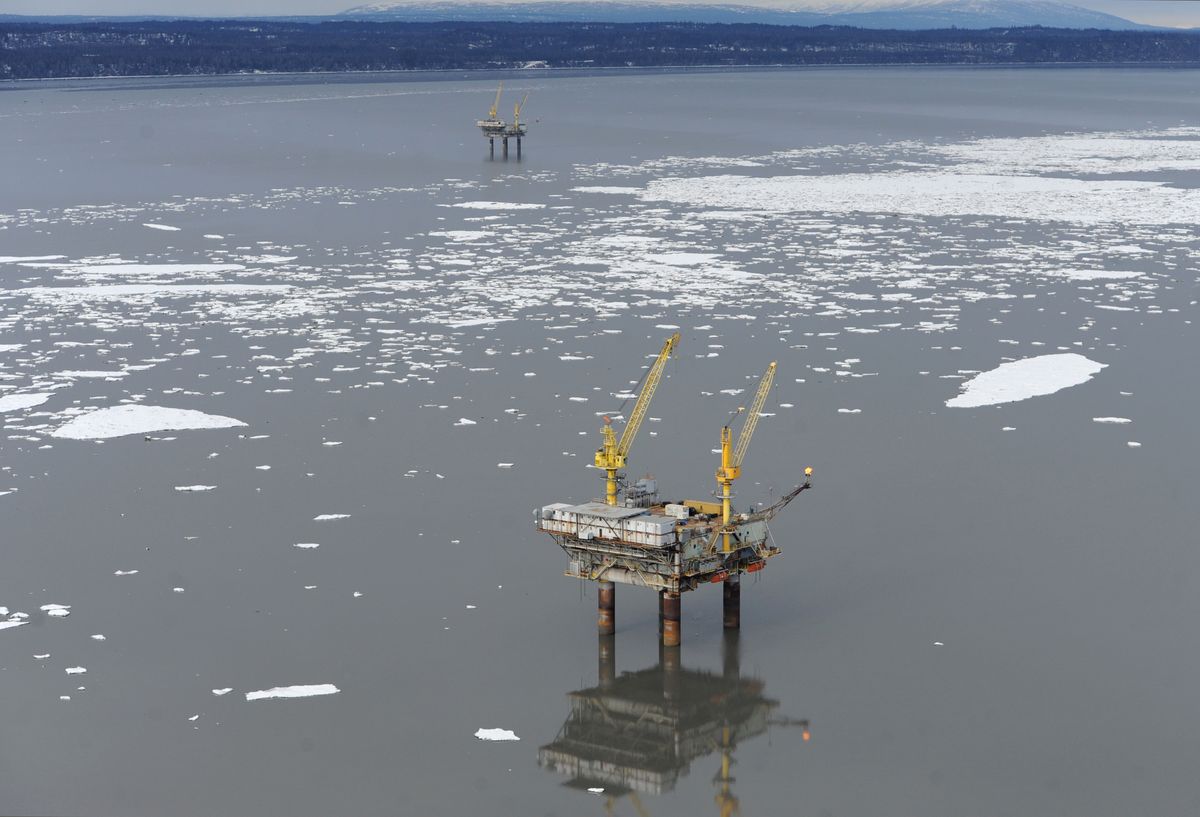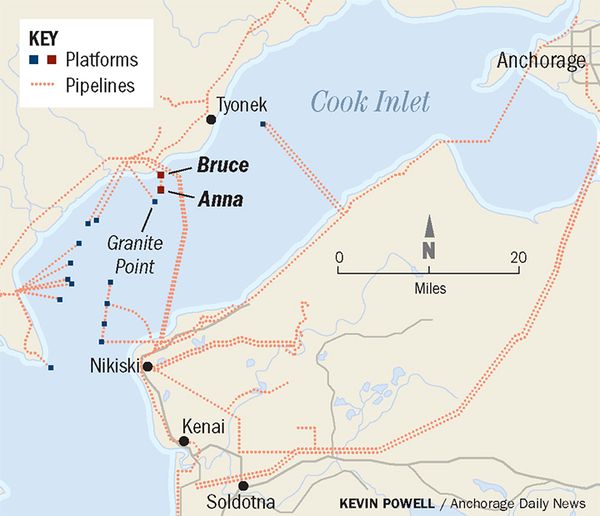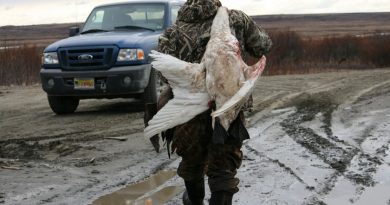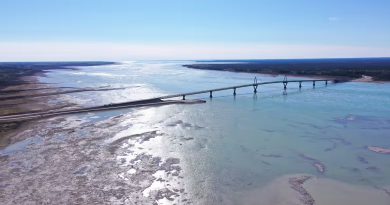Undersea pipeline leak in Alaska: scope and cause of spill still unknown

The flow of oil from an undersea pipeline leaking in Cook Inlet was halted Sunday, one day after the leak was noticed by workers on a Hilcorp Alaska offshore platform, state officials said.
What’s not yet known is how much crude oil escaped from the pipeline into the waters of the inlet — or what caused the leak.
A sheen of oil was discovered at about 11:20 a.m. Saturday by workers on Hilcorp’s Anna platform, about 45 miles southwest of Anchorage near the village of Tyonek, on the west side of Cook Inlet. The workers felt a violent shudder on the platform shortly before discovering the oil sheen, according to the state Department of Environmental Conservation; a flyover found patches of oil sheen about 3 miles downstream from the platform a short time later.
The flow of oil to the pipeline was immediately stopped after the sheen was discovered. But the pipeline itself — which connects the Anna and Bruce platforms, both built in the 1960s — was full of about 460 barrels of crude oil, the DEC said.
The leak is not related to an ongoing natural gas leak at Hilcorp’s platforms near Nikiski.
Quick response
On Sunday, the DEC, U.S. Coast Guard and Hilcorp announced that a “unified command center” had been established to respond to the spill. Inspectors with the Coast Guard and state flew to the Anna platform Sunday morning.
Not every leak results in an incident command, said Kristin Ryan, the head of the DEC’s division of Spill Prevention and Response. But the Anna platform leak warranted it because of the “sensitivity to spills in Cook Inlet” and the “fact that there’s the potential for ongoing release.”
On Sunday, workers focused on stopping the potential release of oil sitting in the pipeline. A foam “pig” projectile was sent through the pipeline to displace the existing oil with seawater, which Ryan said acted like a “squeegee,” pushing the oil past a joint of the aging pipeline from which the oil was believed to be leaking. The oil would be pushed all the way to the Bruce platform, Ryan said.
Pigging “won’t stop the leak, but pulls the oil away from the leak,” she said. “The only thing leaking then would be water.”
As of about 4:30 p.m. on Sunday, the pigging operation was still underway, but had passed the crucial joint juncture.
“It’s a success,” she said.
The operation was expected to be finished by about 8 p.m.
Waiting for divers

No additional oil sheen had been seen on the water in several monitoring flights, Ryan said.
An oil-spill response contractor, Cook Inlet Spill Response Inc., has a vessel on-site.
A flight over the Anna platform Sunday evening revealed mostly open water surrounding it, though a long, thick band of broken ice stretched between Anna and the nearby Bruce platform. Other large rafts of ice loomed not far away. Two vessels were also in the area, though at a distance from the Anna platform. No sheen was visible on the dark-colored water.
The state did not have an estimate Sunday for how much oil spilled into Cook Inlet.
And they don’t know for sure how or where the leak started.
“This is a little complicated because (the pipeline) is 75 feet underwater,” Ryan said. “It’s a little difficult to know what’s going on without a diver in the water.”
Early spring conditions in Cook Inlet — including sheets of “pancake ice” on the surface of the water and extreme tides — make diving in the area dangerous. Still, by Sunday afternoon, plans were being made to deploy divers to assess the situation.
“A diving (contractor) is anticipated to arrive late this week to investigate the line and conduct repairs as necessary,” the DEC said in an update on the leak.
Concerns for the environment
Gov. Bill Walker said in a statement that he was “deeply concerned” about potential environmental impacts of the spill.
Spring brings fish, birds and marine mammals to the inlet, including endangered populations of beluga whales and Steller sea lions. No oiled animals have been spotted so far by monitors, Ryan said Sunday evening.
Environmental and citizens groups say they are watching what happens closely.
“We’re really worried about what this means for Cook Inlet belugas with the double whammy of an oil spill and gas leak in the same season,” Miyoko Sakashita, the oceans program director for the Center for Biological Diversity, said in a statement.
Sakashita said Hilcorp’s growing problems in Cook Inlet should disqualify the company from pursuing offshore oil drilling in the Arctic.
Aging oil infrastructure in Cook Inlet requires heightened monitoring and oversight, said Lynda Giguere with the Cook Inlet Regional Citizens Advisory Council.
“Some of these lines were put in in the mid-1960s,” she said.
Hilcorp’s “history of noncompliance”
Houston-based Hilcorp is the main producer of oil in Cook Inlet. In 2011, it entered the Alaska market by buying up some of Cook Inlet’s aging oil and gas infrastructure from Chevron. The company’s tenure in the state has not always been smooth; the company has been fined by the Alaska Oil and Gas Conservation Commission, which has said the company has a “history of noncompliance” in Alaska.
Lori Nelson, a spokeswoman for Hilcorp Alaska, did not return calls Sunday.
Now that the leak is stopped, the state will focus on investigating what happened, Ryan said.
“We shift to a fact-finding mission about the integrity of the line, inspections.”
“The state has a zero-tolerance policy for release of oil into the environment,” Ryan said. “This is a big deal to us.”
Related stories from around the North:
Canada: Arctic offshore drilling too dangerous: Trudeau, Radio Canada International
Finland: Finland carbon neutral by 2045 says country’s environment minister, Yle News
Norway: Norway proposes massive opening of Arctic shelf to oil drilling, The Independent Barents Observer
Norway: European Parliament calls for ban on oil drilling in icy waters, The Independent Barents Observer
Russia: Russia mulls tougher action against oil polluters of Arctic coast, The Independent Barents Observer
Sweden: Swedish government unveils new climate law, Radio Sweden
United States: Fines and leaks: Troubles mount for oil and gas company Hilcorp in Alaska and Outside, Alaska Dispatch News



